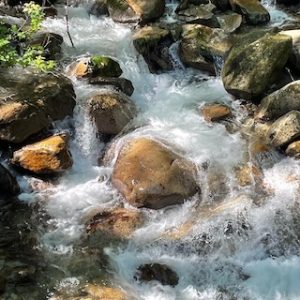 The Columbia City Yoga on-line Moving into Meditation class met this morning. We focused on how we experience attention. Our experience of how we attend determines our aliveness. Tuning into our natural vitality as a source of support can release us from the tension of trying too hard.
The Columbia City Yoga on-line Moving into Meditation class met this morning. We focused on how we experience attention. Our experience of how we attend determines our aliveness. Tuning into our natural vitality as a source of support can release us from the tension of trying too hard.
Our inner aliveness can buoy us up like a boat on water.
We drew inspiration and guidance from Oren Jay Sofer’s new book: Your Heart Was Made for This: Contemplative Practices for Meeting a World in Crisis with Courage, Integrity, and Love. We continued our focus on attention – specifically how we pay attention.
We also drew inspiration from Insight Meditation teacher, Gil Fronsdal’s teaching. Gil and his fellow teachers offer a library of talks, guided meditations and courses through AudioDharma. You can experience his guided meditation, Vitality, in this archive.
We heard Anne Hillman’s poem, We Look with Uncertainty. The poem, from her collection Awakening the Energies of Love: Discovering Fire for the Second Time. The poem is a “dare” to be human in our vulnerability and openness.
 We drew from the tenth chapter of Kathleen Dowling Singh’s book, The Grace in Aging: Awaken As You Grow Older. In this section, Commitment: Liberation from Deception, Kathleen focuses on the precious gift of our attention. She reminds us that “we’re here to learn from each other. . . . We’re here to share with each other, to comfort and be comforted, to be present with each other.”
We drew from the tenth chapter of Kathleen Dowling Singh’s book, The Grace in Aging: Awaken As You Grow Older. In this section, Commitment: Liberation from Deception, Kathleen focuses on the precious gift of our attention. She reminds us that “we’re here to learn from each other. . . . We’re here to share with each other, to comfort and be comforted, to be present with each other.”
Guided Reflection
 Last week we explored attention as one of our most precious inner resources. We considered how attention makes love and connection possible. Like flowers opening, we can open our hearts to what we pay attention to. Attention can help us consider what our hearts are made for. Oren Jay Sofer asks: What conditions support your choosing what you do with your attention? What do you control and how can you move in that direction?
Last week we explored attention as one of our most precious inner resources. We considered how attention makes love and connection possible. Like flowers opening, we can open our hearts to what we pay attention to. Attention can help us consider what our hearts are made for. Oren Jay Sofer asks: What conditions support your choosing what you do with your attention? What do you control and how can you move in that direction?
For the past week I’ve been observing how I pay attention. I’ve been studying my habits of attention. How I give it to media screens and books. How I offer it to other people. How I devote it to thought patterns. All of these verbs imply choice. Yet often I find myself impulsively answering calls for attention. Or I don’t notice I’m giving my attention to something until I wake up somehow.
I am learning a lot and it seems to be an inexhaustible effort. I find myself resisting the exercise and wanting to do what I habitually do. There seems to be an addictive component to some of my habits. I’ve been placing my hands in my lap when sitting before the computer and asking myself: What is my purpose? Sometimes I give my time to something worthy – like writing or learning. Often it’s about scratching an itch to be distracted or entertained.
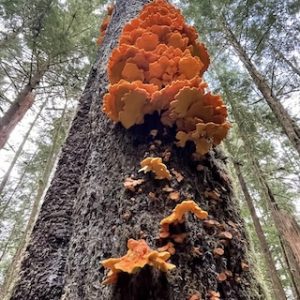 I’ve started choosing to do something else – being in silence, listening to music, doing chores, calling a friend or family member – and doing only that one thing. I’ve also started a type of metacognition practice: being aware of how I am aware; how I approach daily meditation. Meditation teacher Gil Fronsdal talks about the inner states we bring to our practice. One of them is our natural vitality. He says:
I’ve started choosing to do something else – being in silence, listening to music, doing chores, calling a friend or family member – and doing only that one thing. I’ve also started a type of metacognition practice: being aware of how I am aware; how I approach daily meditation. Meditation teacher Gil Fronsdal talks about the inner states we bring to our practice. One of them is our natural vitality. He says:
Vitality isn’t dependent on what we’re doing but how at ease we are in ourselves. . . . How awake we are. How much clarity there is in our being as we are right now. . . . Once we have [a] kind of settled relaxed calm vitality . . . there is an upwelling of a . . . sense of aliveness that . . . can buoy us up, that can support us. . . . So when we meditate it’s not a matter of applying effort. . . . It’s rather [like] a boat riding the waves [of] natural vitality, the natural aliveness that’s here within us. . . . It’s kind of a floating on the movement and the energy that’s going on as the body breathes.
Wonderful meditation teachers, Oren and Gil, have inspired me to re-examine my approach to practice and to life. Gil believes this “settled vitality” is a good way of being alive and also a reference point to see how we meet our lives. The stress of trying too hard comes along with tension. He says
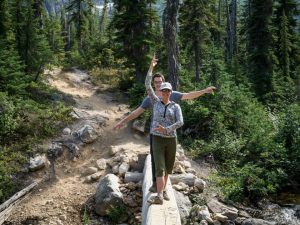 . . . that tension carries momentum. Stress generates more stress. We’re stressful so we try harder – we don’t like the stress that comes from trying harder and so . . . the solution is to try harder.
. . . that tension carries momentum. Stress generates more stress. We’re stressful so we try harder – we don’t like the stress that comes from trying harder and so . . . the solution is to try harder.
He recommends that we
. . . start feeling the . . . energetics of our thinking habits, [our] thinking loops. That’s the how you’re making the effort . . . the tension that’s there. Then you can [consider]: is this how I want to live? Which is one of the central Buddhist questions. How do you want to be? Not what do you want to be. How do you want to be alive here and now?
How do we want to be? How do we attend to things that will determine our experience of being? How do we want to be alive? Here is a Anne Hillman’s poem that can help us live these questions:
We Look With Uncertainty
 We look with uncertainty
We look with uncertainty
beyond the old choices for
clear-cut answers
to a softer, more permeable aliveness
which is every moment
at the brink of death;
for something new is being born in us
if we but let it.
We stand at a new doorway,
awaiting that which comes…
daring to be human creatures,
vulnerable to the beauty of existence.
Learning to love.
Let us experience these living questions with a sense of receptivity – as if “we were standing at a new doorway, awaiting that which comes… daring to be human creatures, vulnerable to the beauty of existence. Learning to love.”
I invite you to adjust your posture as you need to be aware and at ease. Give yourself a few moments to let all those words move through you. You might take a few deep, slow breaths. Relax what you can. Notice the quality of aliveness you feel. Notice how energy may be expressing in your body: perhaps as relaxation or tension, hardness or softness, subtle currents of energy, warm pulsations or buzzy vibrations. Notice whatever you can. Be with whatever you can.
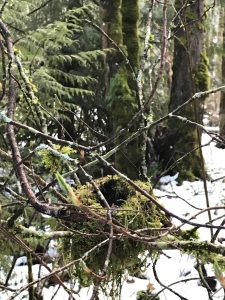 If there is a sense of doing see if you can relax and let that be? You can let that float on the natural energy of awareness. Let that sense of aliveness support you. Stay with the truth of what’s happening in your experience as effortlessly as you can.
If there is a sense of doing see if you can relax and let that be? You can let that float on the natural energy of awareness. Let that sense of aliveness support you. Stay with the truth of what’s happening in your experience as effortlessly as you can.
Your Body may take a deeper breath now and then or it might swallow. Can you allow experience and sensation, thought and sound appear in your awareness? Perhaps poignant memories, joys and pains, spontaneously arise and subside. You can notice how they change as continuous waves of energy. This energy is always now, the ever present. You can notice what surfaces and allow how its energy feels. The unknown arises and you can see life revealing itself. Is it possible to entrust yourself to the ever present, to the mystery?
You might discover how really tired you are underneath all the doing – all the work of being a self. We are living with ongoing stress and many difficulties beyond our control. What is it like to let go if just for a little while?
 Body speaks truth, and then another truth, and then another one. We feel our way through the ever-changing world. We might bring loving awareness to everything we know and everything we don’t know. When we lose ourselves – in anger, in fear, in grief, in joy, we can always come home: Body feeling, looking, touching and loving. Right now you might gently curl and uncurl your fingers. Feel how precious these hands! Or moisten your lips with the tip of your tongue. Slowly roll your head to one side and then the other.
Body speaks truth, and then another truth, and then another one. We feel our way through the ever-changing world. We might bring loving awareness to everything we know and everything we don’t know. When we lose ourselves – in anger, in fear, in grief, in joy, we can always come home: Body feeling, looking, touching and loving. Right now you might gently curl and uncurl your fingers. Feel how precious these hands! Or moisten your lips with the tip of your tongue. Slowly roll your head to one side and then the other.
Our experience utterly depends upon how we choose to offer our attention. I invite you to take a moment and reflect on how you are aware. How is awareness shaping your life?
Teacher Kathleen Dowling Singh writes:
. . . here we are, today, giving the gift of our attention, learning and sharing. . . . our hearts open every time they close. One breath follows another in and out of our Body home. Perhaps 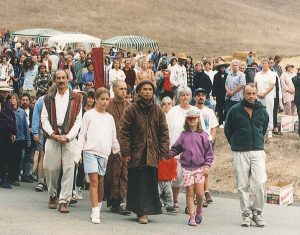 this is why we are here. . . . Mindful of each breath, we increase our capacity to show up in our lives . . . We will come to know that there is nowhere to go except more deeply into tender communion with all that is . . . We live in interbeing, wishing each other awakening
this is why we are here. . . . Mindful of each breath, we increase our capacity to show up in our lives . . . We will come to know that there is nowhere to go except more deeply into tender communion with all that is . . . We live in interbeing, wishing each other awakening
May all beings know the support of inner and outer safety. May they be well in body and mind. May they know the ease and joy of kinship and peace.
